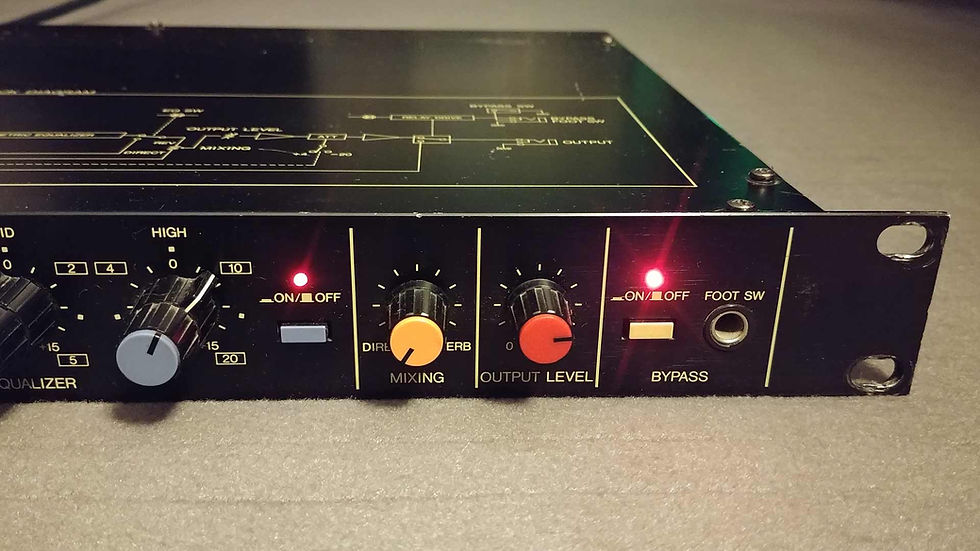[1984] Yamaha R1000 Digital Reverberation
- Kevin Ulliac
- Jul 5, 2020
- 3 min read
I love vintage analog and vintage digital gear. I would absolutely love to get my hands on an API-2500 compressor, some SSL EQ's, some Neve 1073 preamps, and you name it. There's no doubt that those pieces of gear have become renowned in the industry simply because they impart a special character to the resulting audio that is extremely pleasing and their quality of sound is unmatched... but of course, they come at a premium.
But occasionally, if one looks long enough, or in the right places, there are plenty of opportunities to pick up great lesser known pieces of gear, that are not in the spotlight, and that have transitioned into paper weights and dust collectors, as opposed to their intended use case.
In particular, I want to focus on is one unit, the Yamaha R1000 mono 12-bit Digital Reverb with a 3-band EQ [released in 1984]. It seems to me that only in recent years have people started to appreciate the low bit depth coloration of vintage digital gear. This unit in particular has some fantastic old school 12-bit digital grit that adds interesting character to boring static and clean sounds, and it's remarkably cheap!
I've put together a full audio demo on how it sounds. I'm using this device as a reverb send effect. I adjust send levels, switch between the 4 different reverb modes, and tweak various EQ settings to my liking. Overall, the unit has a very old school/vintage sound that's great for getting and old school Dub or 80s sound, but with strategic EQ settings it can sound rather lush.
Here's what the device looks like:

There are 4 reverb modes, each mode 1 thru 4 has a progressively longer decay time [to be specific, the decay times are 1.5, 1.6, 2.3, and 2.4 seconds respectively]. From my ears, it sounds like each one has a slightly different response to the input in terms of overall tone.

There's an input level control and easily adjustable 3-band EQ (with a bypass On/Off switch). You can boost or cut up to 15dB in each band as follows: lows (50Hz - 700Hz), mids (350Hz - 5kHz), and highs (2kHz - 20kHz). This EQ section is very key to getting a workable reverb sound as the raw reverb output can be a bit overpowering (especially in the mids/highs).

There's a "Mixing" knob that will blend between direct (dry) signal and reverb (wet) signal. Important if you are using it as an insert, less important if you are using it as a send effect. There's also an Output Level control, a bypass "On/Off" switch, and a foot switch input.

On the back you'll find 1/4 inch input and output connectors along with In & Out inserts which allows you to process the input signal before going thru the reverb processing. The level switch allows you to select between -20dB and +4dB connectivity standard.

The unit was manufactured for use in several continents so it will either come in 120v, 100v, or 240v. So if you're going to purchase one, make sure it matches the voltage requirements of your continent/country.

When doing more research on this unit, I found a really cool article found in the Home Studio Recording Magazine, January 1984 issue.

It has a full page description of the device:

There's also some formal specifications at the end:

All in all, I have to say that this unit has earned a special place in my home studio. I actually put together this audio demo video because I was thinking of selling the unit. I decided I'd test its capabilities on many different types of audio tracks, document the results, and if I didn't really like it I'd use the video to sell it. Needless to say, I realized why I bought it in the first place, and the amount of money I'd get for it was not nearly worth letting go of it.
I don't use it all the time, but it's a fun device to experiment with, especially when I'm looking to add some grit and character to dry static sounds. I'll route the mono or stereo signal through my Yamaha M406 rack mount mixer, send it to the Yamaha R1000, split the mono signal into 2 Boss DE-200 delay units, usually create a kind of ping pong delay effect, and go back into my DAW.
There's something satisfying about routing audio through analog gear, twisting knobs and tweaking with settings, messing around to make some happy little accidents, recording it down to a fully committed piece of audio that may never be able to be replicated again. At the very least it's something different from a digital plugin that I have to tweak one setting at a time using a mouse pointer.



![[FIX]: Akai S3000XL waiting for hard disk ready.. SKIP](https://static.wixstatic.com/media/b474e9_8236d6da83cb45e3acacf5f0f821b38f~mv2.jpg/v1/fill/w_980,h_551,al_c,q_85,usm_0.66_1.00_0.01,enc_avif,quality_auto/b474e9_8236d6da83cb45e3acacf5f0f821b38f~mv2.jpg)
![[1983] Yamaha DX7 FM Synth - Electric Piano 1 (patch demo)](https://static.wixstatic.com/media/b474e9_a946e069ef77472a8db71ba0b4a969b2~mv2.jpg/v1/fill/w_980,h_551,al_c,q_85,usm_0.66_1.00_0.01,enc_avif,quality_auto/b474e9_a946e069ef77472a8db71ba0b4a969b2~mv2.jpg)
Comments